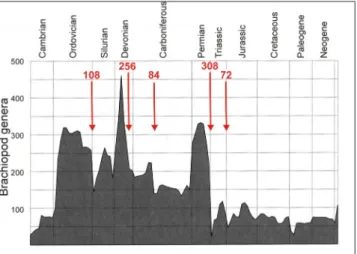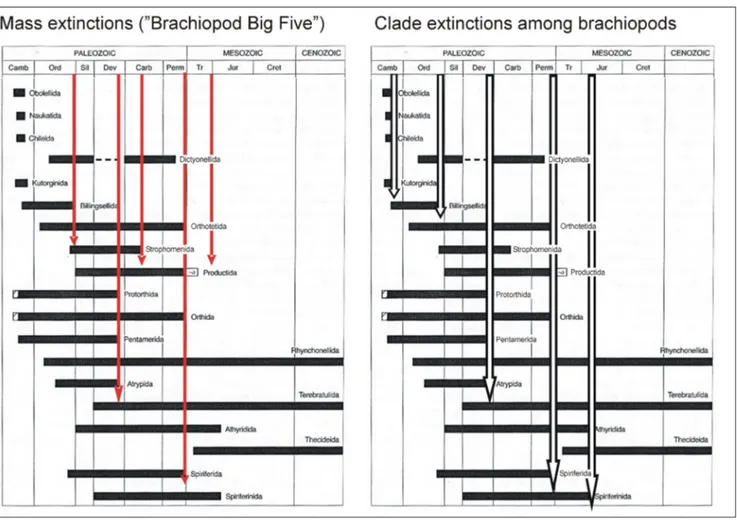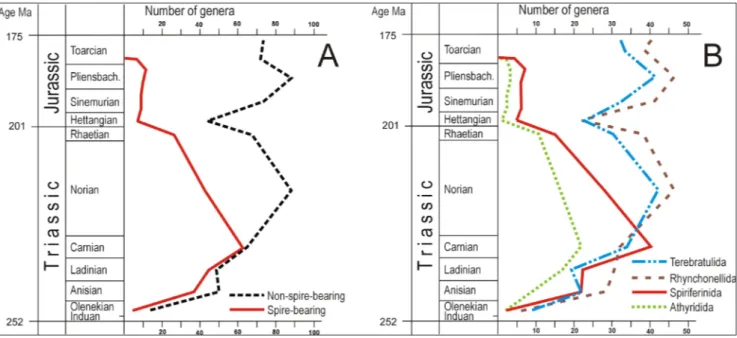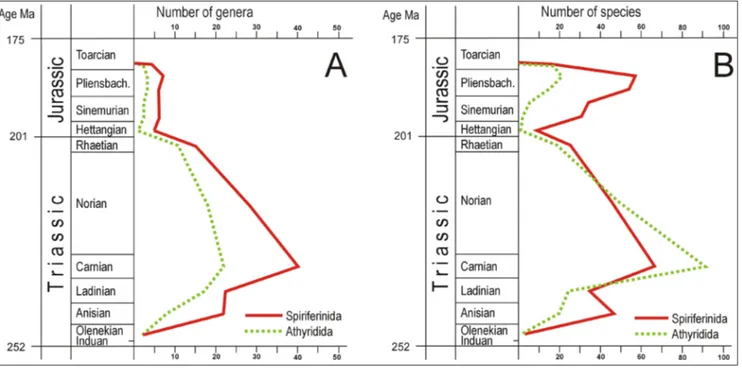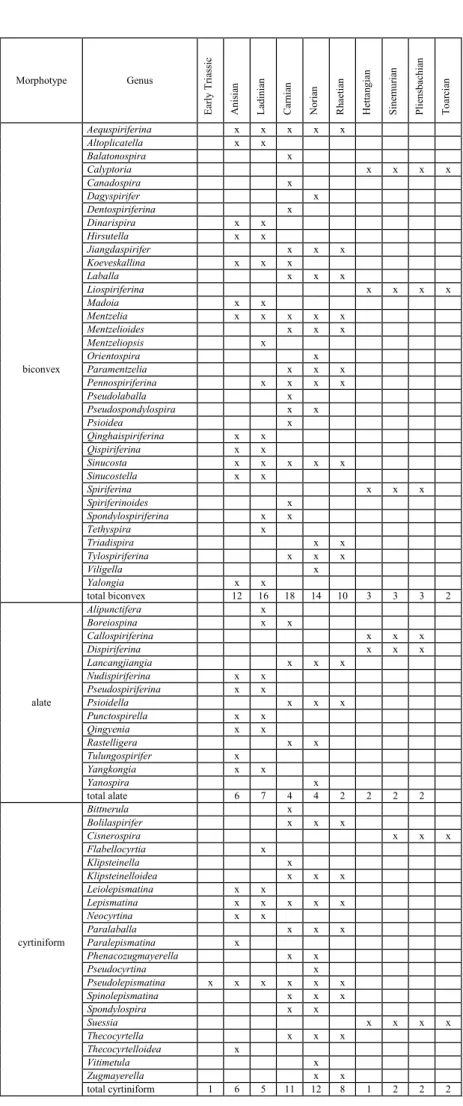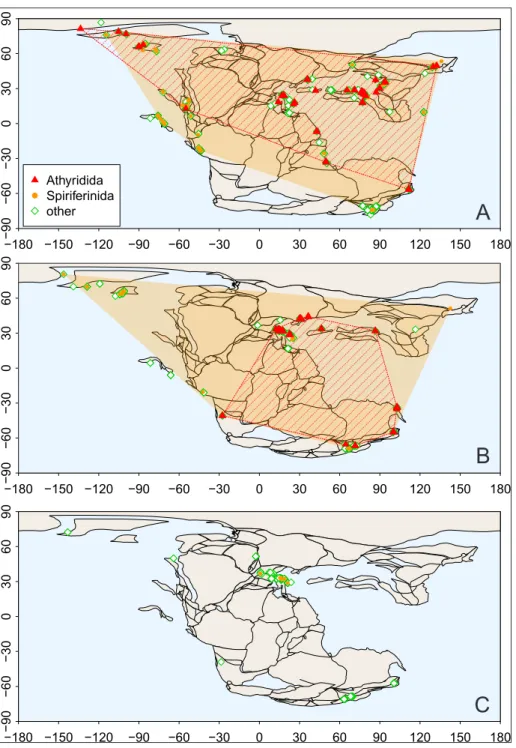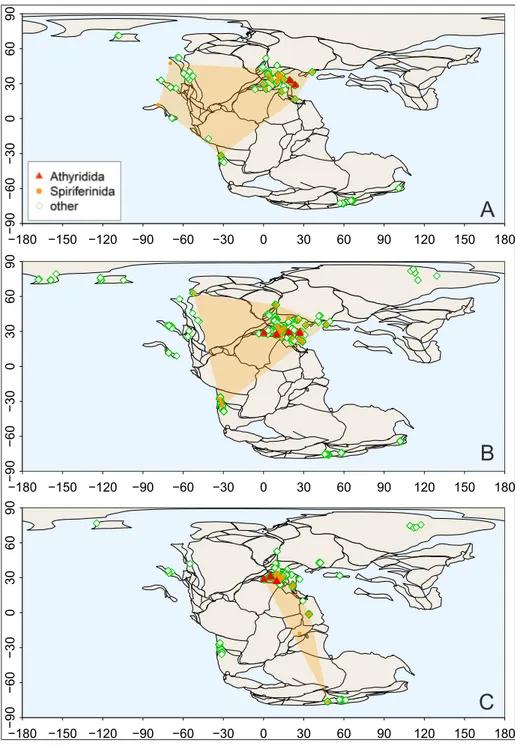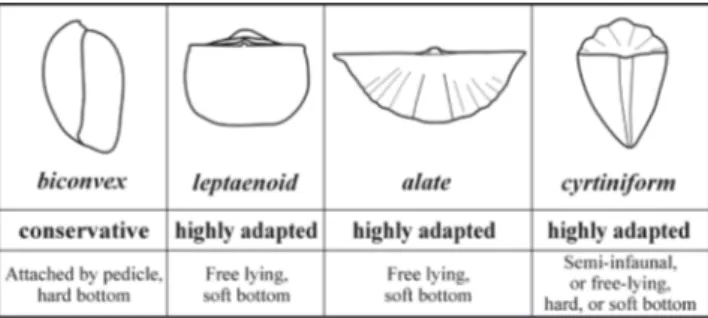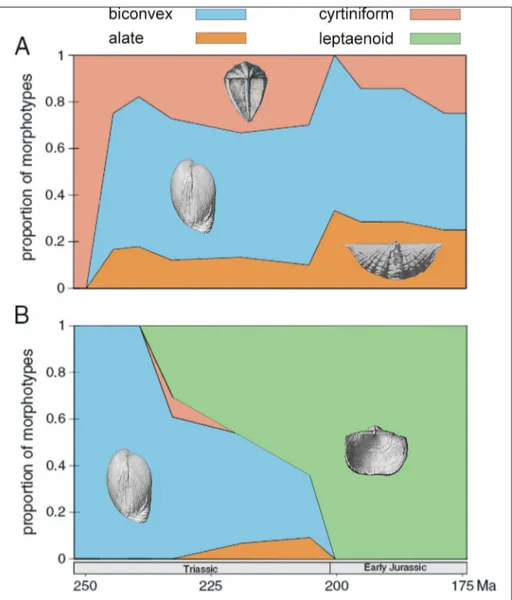MASS EXTINCTIONS AND CLADE EXTINCTIONS IN THE HISTORY OF
BRACHIOPODS: BRIEF REVIEW AND A POST-PALEOZOIC CASE STUDY
ATTILA VÖRÖS1,2*, ÁDÁM T. KOCSIS2,3 & JÓZSEF PÁLFY2,4
1*Corresponding author. Department of Paleontology and Geology, Hungarian Natural History Museum, POB 137, Budapest H-1431,
Hungary. E-mail: [email protected]
2MTA-MTM-ELTE Research Group for Paleontology, POB 137, Budapest H-1431, Hungary.
3GeoZentrum Nordbayern, Department of Geography and Geosciences, University of Erlangen-Nuremberg, Loewenichstraße 28, 91054
Erlangen, Germany. E-mail: [email protected]
4Department of Geology, Eötvös University, Pázmány Péter sétány 1/C, Budapest H-1117, Hungary. E-mail: [email protected]
To cite this article: VörösA., KocsisÁ.T. & PálfyJ. (2019) - Mass extinctions and clade extinctions in the history of brachiopods: brief review and a post-Paleozoic case study. Riv. It. Paleont. Strat., 125(3): 711-724.
Rivista Italiana di Paleontologia e Stratigrafia (Research in Paleontology and Stratigraphy)
vol. 125(3): 711-724. November 2019
Abstract. Brachiopods are a key group in Phanerozoic marine diversity analyses for their excellent fossil record
and distinctive evolutionary history. A genus-level survey of raw diversity trajectories allows the identification of the Brachiopod Big Five, episodes of major genus losses in the phylum which are compared with the established Big Five mass extinctions of Phanerozoic marine invertebrates. The two lists differ in that the end-Cretaceous extinction appears subdued for brachiopods, whereas the mid-Carboniferous is recognized as an event with significant loss of brachiopod genera. At a higher taxonomic level, a review of temporal ranges of rhynchonelliform orders reveals episodes of synchronous termination of multiple orders, here termed clade extinctions. The end-Ordovician, Late Devonian and end-Permian events are registered as both mass extinctions and clade extinctions. The Late Cambrian and the Early Jurassic are identified as the other two clade extinction events. Coincident with the Early Toarcian oceanic anoxic event, the last clade extinction of brachiopods is defined by the disappearance of the last two spire-bearing orders, Athyridida and Spiriferinida. Their diversity trajectory through the recovery after the end-Permian crisis parallels that of the extant terebratulides and rhynchonellides until a Late Triassic peak but diverge afterwards. The end-Triassic diversity decline and Toarcian vanishing of spire-bearers correspond with contraction in their spatial distribution. The observed patterns and extinction selectivity may be explained both ecologically and physiologically. The specialized adaptation of morphologically diverse spire-bearers, as well as their fixed lophophore and passive feeding put them at a disadvantage at times of environmental crises, manifest in their end-Triassic near-extinction and Toarcian demise. Similar analyses of other clade extinctions may further improve our understanding of drivers and processes of extinction.
Received: February 28, 2019; accepted: August 1,2019
Keywords: Rhynchonelliformea; diversity; spire-bearers; biotic crises; end-Triassic; Toarcian.
I
ntroductIonBrachiopods are a key fossil group in the Paleozoic evolutionary fauna of Sepkoski (1981), characterized by a distinctive diversity history. The phylum reached the peak of its adaptive and evolu-tionary success in the second half of the Paleozoic
and became a subordinate player in the shallow-ma-rine benthic communities after the end-Permian bi-otic catastrophe.
During their Paleozoic heyday, brachiopods developed free-lying, semi-infaunal and possibly free-swimming ways of life and extremely varied morphologies and ornamentation styles, and at-tained extremely high taxonomic diversity (Rud-wick 1970; Curry & Brunton 2007). (Note that in
VörösA., KocsisÁ.T. & PálfyJ.
712
this study, we use the term diversity to refer to sim-ple taxic richness, either at species, genus or higher taxonomic level). However, after the end-Permian crisis and during the Mesozoic marine revolution (Vermeij 1977), rhynchonelliform brachiopods re-turned to the conservative modes of life with pedi-cle attachment or cementation and, as reflected by their considerably reduced diversity, were outcom-peted by bivalves (Gould & Calloway 1980; Thayer 1985; Walsh 1996).
The long and eventful history of the phylum Brachiopoda is replete with extinction events of different magnitudes. The major drops in the clas-sical diversity curve of marine invertebrates (Raup & Sepkoski 1982), i.e. the originally identified “Big Five” mass extinctions, are unquestionably recog-nizable in the updated generic abundance curve of brachiopods (Curry & Brunton 2007). However, there are some important differences in the magni-tude, timing, and significance of these events. Some of these deviations are discussed in this paper.
In the first part, we briefly review the dif-ferences between the established Big Five and the “Brachiopod Big Five” events, i.e. the five greatest mass extinctions of brachiopods, in terms of ge-neric abundance. We also introduce here the term “clade extinction”, a useful concept to discuss ex-tinctions at the higher taxonomic level of orders, for those events when entire brachiopod clades van-ished. The second part presents a case study with a concise discussion of the last, post-Paleozoic clade extinction of the brachiopods in the Early Jurassic.
M
assextInctIons andclade extInctIons In the hIstory of brachIopodsThe following brief review will focus on the history of the subphylum Rhynchonelliformea (Articulata auctt.) which chiefly accounts for the dramatic changes in brachiopod diversity, much more than the other two subphyla, the Linguli-formea and CraniiLinguli-formea. Changes in the gener-ic abundance of brachiopods (Curry & Brunton 2007) clearly show the signs of several crises in ancient marine ecosystems. Most of the Big Five mass extinctions appear also on this brachiopod diversity curve: the end-Ordovician, Late Devoni-an, end-Permian and end-Triassic events are eas-ily recognizable (Fig. 1). On the other hand, the famous fifth of the Big Five, the end-Cretaceous event, appears subdued and was perhaps less dra-matic for brachiopods. Alternatively, a more rapid recovery may have masked the diversity decrease at low temporal resolution (Alroy et al. 2008). Of the four events of the Brachiopod Big Five that clearly coincide with the classical Big Five, the greatest was the end-Permian with 308 genera becoming extinct, closely followed by the Late Devonian (256). The end-Ordovician event ranks third (108), whereas the end-Triassic appears the smallest of the brachi-opod mass extinctions with the disappearance of 72 genera (data from Curry & Brunton 2007). Con-versely, the fourth in rank among the Brachiopod Big Five, in the mid-Carboniferous with 84 genera becoming extinct, does not correspond to any of the classical Big Five.
Mass extinctions are commonly analyzed at low taxonomic levels and measured in terms of ra-tio of taxic loss across stratigraphic boundaries. For our study, the Brachiopod Big Five extinctions and the post-Paleozoic decline are demonstrated using the simple count of genera. On the other hand, it seems also worthwhile to analyze the extinction events and the decline of the phylum at a high-er taxonomic level. In the case of Rhynchonelli-formea (Articulata) the highest meaningful level is the rank of orders. The extinction events that mark the final disappearances of orders are termed here clade extinctions, because these events involve ul-timate, definitive losses of the brachiopod groups concerned.
Fig. 1 - Number of brachiopod genera during the Phanerozoic (af-ter Curry & Brunton 2007) and the number of genera that became extinct at the Brachiopod Big Five (indicated by ar-rows).
Mass extinctions and clade extinctions in the history of brachiopods 713
The range chart of the orders of Rhyn-chonelliformea, compiled by Carlson (2007) and adapted here (Fig. 2), shows that the changes in number of orders principally follow the gener-ic diversity curve of Curry & Brunton (2007). It starts with eight orders in the Cambrian, then, after the Devonian peak (12), decreases to nine in the Permian, falls to five in the Triassic, and ends with three extant orders.
More importantly, Figure 2 also shows that the clade extinctions, i.e. the ultimate disappear-ances of orders, are not perfectly in agreement with the Brachiopod Big Five events. The end-Or-dovician, Late Devonian and, most remarkably, the end-Permian extinctions are classified to both types of events. On the other hand, two very signif-icant clade extinctions occurred in the Late Cam-brian (with four orders becoming extinct) and in the Early Jurassic (with two orders lost), which do not correspond to major losses on the generic di-versity curve, hence are not considered among the
Brachiopod Big Five. Admittedly, such compila-tions may not fully capture the complexity of these events, as the temporal resolution may be too crude to reveal the details, especially for the Paleozoic. Nevertheless, the pattern of correspondence and divergence in diversity trajectories at low taxonom-ic levels and clade termination events is insightful.
In the Paleozoic history of the Rhynchonel-liformea, the mass and clade extinctions were com-monly followed by rapid recoveries accompanied by significant morphological innovations (Rudwick 1970; Curry & Brunton 2007). This pattern com-pletely changed after the end-Permian catastrophe. The four surviving orders, Rhynchonellida, Tere-bratulida, Athyridida and Spiriferinida (joined by Thecideida that emerged in the Triassic) show lim-ited recovery and only minor diversity peaks in the Triassic and Jurassic, but largely without any sig-nificant morphological innovation. After the dev-astating end-Permian extinction, the last clade ex-tinction in the history of brachiopods occurred in
Fig. 2 - Comparison between the major mass extinctions (the Brachiopod Big Five) and the clade extinctions (extinctions of orders) among brachiopods. Range charts after Carlson (2007).
VörösA., KocsisÁ.T. & PálfyJ.
714
the Early Jurassic, in the Early Toarcian, when the orders Athyridida and Spiriferinida vanished. Albe-it commonly considered only a second-order ex-tinction event, this minor biotic crisis has received considerable attention (Little 1996; García Joral et al. 2011, 2018; Caruthers et al. 2013; Danise et al. 2018; Piazza et al. 2019) for its coincidence with the Early Toarcian oceanic anoxic event also known as Jenkyns Event (Müller et al. 2017). Herein we ex-plore its significance for brachiopods as the last clade extinction in this phylum. The peculiarity of this event lies in the fact that the last two orders of previously successful and anatomically distinctive spire-bearing forms were lost.
a
nalysIs ofthe lastclade extInctIon ofbrachIopodsIn this case study we present an analysis of the extinction process of the two spire-bearer or-ders surviving the end-Permian, Athyridida and Spiriferinida, i.e. the victims of the last clade ex-tinction event in the history of brachiopods. The study is focused on four rhynchonelliform orders: Rhynchonellida, Athyridida, Spiriferinida and Te-rebratulida. The fifth post-Paleozoic order, Theci-deida is considered of minor significance and not included in our analysis.
MaterIalandMethods
Genus-level occurrence data for the Triassic to Early Jurassic distribution of Athyridida, Spiriferinida, Rhynchonellida and Tere-bratulida were collected from the respective volumes of the Treatise on Invertebrate Paleontology (Álvarez & Rong 2002; Savage et al. 2002; Carter & Johnson 2006; Lee et al. 2006, 2007; Gourvennec & Carter 2007; Curry & Brunton 2007). The Early Jurassic part was further resolved from the level of stages to the level of substages, to better constrain the diversity trajectories in the critical, terminal part of the spire-bearers’ evolutionary history.
Further data for the stratigraphic distribution and range-through diversities of the spire-bearing brachiopods (Athyridida, Spiriferinida) at species-level were collected manually from the avail-able literature, thereby extending the coverage by data not meeting the entry criteria of PaleoDB (Diener 1920; Alméras 1964; Dagys 1974; Siblík 1983, 1988, 2001; Vörös 2002; Comas-Rengifo et al. 2006; Vörös & Dulai 2007). Diversity curves at the genus and spe-cies level were constructed for the Triassic to Early Jurassic interval, calibrated with the time scales of Mundil et al. (2010) and Gradstein et al. (2012).
To track the spatial distribution changes of spire-bearers, Paleobiology Database (PaleoDB) occurrence data of brachiopods from the Triassic to Jurassic interval were downloaded on 17.01.2019. and were resolved to the stratigraphic level of stages. The paleocoor-dinates of the collections were rotated to match the paleogeograph-ic reconstructions of the PALEOMAP PaleoAtlas project (Scotese, 2016). The prepared dataset consists of 8,429 occurrences from 3,680 collections in the Late Triassic-Early Jurassic interval.
The spire-bearer genera were grouped into four morphotype categories: biconvex (i.e. short-hinged, globose), concavo-convex (leptaenoid), expanded (alate), and inaequivalve, conical (cyrtini-form). The occurrences of the genera attributed to these morpho-types were counted by ages of the Triassic to Early Jurassic interval based on the Treatise on Invertebrate Paleontology (Álvarez & Rong 2002; Carter & Johnson 2006; Gourvennec & Carter 2007).
Fig. 3 - Temporal changes in the generic diversity (number of genera) of brachiopod groups in the Triassic and Early Jurassic. A) Diversity of the spire-bearer orders (Athyridida and Spiriferinida) and the other orders; B) diversity of the orders Athyridida, Spiriferinida, Rhyn-chonellida and Terebratulida.
Mass extinctions and clade extinctions in the history of brachiopods 715
r
esultsThe generic diversity of the spire-bearer and the other, non-spire-bearer clades that survived the end-Permian show similar trajectories in the Triassic then, after an end-Triassic bottleneck, their trends markedly deviate in the Jurassic (Fig, 3A). The four brachiopod orders analyzed initially follow a simi-lar trajectory: their Triassic recovery reached a max-imum in the Carnian and Norian. However, the end-Triassic bottleneck of the Rhynchonellida and Terebratulida was followed by a secondary bloom in the Early Jurassic, whereas the end-Triassic near-ex-tinction of the spire-bearer Athyridida and Spirife-rinida was succeeded by only a subdued diversity increase in the Early Jurassic and vanishing in the Toarcian (Fig. 3B).
The species diversity curves for the spire-bear-er ordspire-bear-ers diffspire-bear-er considspire-bear-erably from the trajectories of their generic diversity (Fig. 4A, B). The number of spiriferinid genera continuously exceeds that of the athyridides, especially in the Triassic. On the other hand, the species diversity of the athyridides sig-nificantly surpasses that of the spiriferinids at the Triassic (Carnian) maximum (Fig. 4B). The Early Ju-rassic parts of the generic diversity curves display persistently low values for both spire-bearer orders. In contrast, their species diversities show a
second-ary bloom in the Early Jurassic (Fig. 4B). The Pliens-bachian peak of Spiriferinida is especially notewor-thy, almost reaching their Triassic maximum value.
The geographical occurrence patterns of the two spire-bearer orders (Athyridida, Spiriferinida) and the other (non-spire-bearer) brachiopod orders (Rhynchonellida and Terebratulida) are presented in successive maps from the Norian to the Toarcian (Figs. 5, 6). The geographic range of spire-bearing brachiopods considerably decreased after the Trias-sic-Jurassic boundary, compared to other forms.
The changes in proportion of morphologi-cal types of spire-bearing genera during the Trias-sic-Jurassic interval are summarized in Tables 1 and 2. In the Triassic, different adaptive morphotypes were abundant in both spire-bearing orders. After the end-Triassic extinction, the alate and cyrtiniform morphotypes, besides the conservative biconvex shells, persisted up to the Early Toarcian among the Spiriferinida. The order Athyridida was represent-ed exclusively by the leptaenoid morphotype in the Early Jurassic.
d
IscussIonDemise of the last two spire-bearing brachiopod or-ders. Statistical analyses of diversity histories and
tax-Fig. 4 - Temporal changes in the taxic diversity (i.e. richness) of the spire-bearer orders (Athyridida and Spiriferinida) in the Triassic and Early Jurassic. A) Number of genera; B) number of species.
VörösA., KocsisÁ.T. & PálfyJ.
716
onomic rates of spire-bearing vs. non-spire-bearing brachiopods confirm that the spire-bearing groups were indeed significantly more affected by both the end-Triassic and Early Toarcian environmental cri-ses (Figs. 3, 4). Both spire-bearing orders reached their maximum Triassic diversity in the Carnian and were only slightly surpassed by terebratulides and rhynchonellides in the Norian. Athyridida and Spiriferinida were severely affected by the end-Tri-assic crisis and had a short and limited recovery before their final extinction in the Early Toarcian Jenkyns Event, providing an example of the “dead clade walking” concept of Jablonski (2001; 2002). The demise of the Athyridida and Spiriferinida was the last clade extinction, registering the loss of two orders within the phylum Brachiopoda.
The worldwide end-Triassic and Toarcian extinction events imposed severe contractions in the taxonomic diversity of brachiopods. Howev-er, the post-Permian diversity history of the four
articulate brachiopod orders diverged significantly. The end-Triassic extinction appeared as a signif-icant bottleneck for all of them, while the Early Toarcian event, a minor bottleneck for the rhyn-chonellides and terebratulides, was a clade extinc-tion for the spire-bearer Athyridida and Spirifer-inida.
The end-Triassic bottleneck and the Early Toarcian extinction in time and space. Both the end-Triassic bottleneck in the diversity and the Toarcian partial extinction are reflected in the spatial distribution of brachiopods (Figs. 5, 6). In the Late Triassic, all of the four rhynchonelliform orders were glob-ally distributed. By the Hettangian, the scatter of their occurrences became strongly reduced, with a focus in the western Tethys (including the Gond-wanan and Laurasian seaways), and a similar spatial contraction is seen in the Toarcian.
The geographical distribution of the two spire-bearing orders even more clearly demon-Table 1
Attribution of athyridid genera to different morphotypes and their distribution in the Triassic to Early Jurassic interval
Morphotype Genus Ea rly Tr ia ssi c A nis ia n La di ni an Ca rn ian N or ia n Rh aet ia n H et tan gi an Sin em ur ia n Pl ien sb ach ian To ar ci an biconvex Amphitomella x Anisactinella x x x Anomactinella x x Dioristella x Diplospirella x Euractinella x x Hustedtiella x Majkopella x x x Misolia x Neoretzia x x x x Ochotathyris x Oxycolpella x x x Pentactinella x x Pexidella x x x x Qingthyris x x Schwagerispira x x x Septospirigerella x x x x x x Spirigerellina x x x x Stolzenburgiella x x Tetractinella x x total biconvex 3 9 12 14 7 3 leptaenoid Amphiclina x x x Amphiclinodonta x x x x x x Carinokoninckina x x x Koninckella x x x x x x x Koninckina x x x Koninckodonta x x x Lamellokoninckina x x x Septamphiclina x x x total leptaenoid 7 7 7 2 3 3 2 alate Clavigera total alate 1 x 1 x cyrtiniform Cassianospira Hungarispira x x total cyrtiniform 2
Tab. 1 - Attribution of athyridid genera to different morpho-types and their distribution in the Triassic to Early Juras-sic interval.
Mass extinctions and clade extinctions in the history of brachiopods 717 Morphotype Genus Ea rly Tr ia ssi c A nis ia n La di ni an Ca rn ian N or ia n Rh aet ia n H et tan gi an Sin em ur ia n Pl ien sb ach ian To ar ci an Aequspiriferina x x x x x Altoplicatella x x Balatonospira x Calyptoria x x x x Canadospira x Dagyspirifer x Dentospiriferina x Dinarispira x x Hirsutella x x Jiangdaspirifer x x x Koeveskallina x x x Laballa x x x Liospiriferina x x x x Madoia x x Mentzelia x x x x x Mentzelioides x x x Mentzeliopsis x Orientospira x biconvex Paramentzelia x x x Pennospiriferina x x x x Pseudolaballa x Pseudospondylospira x x Psioidea x Qinghaispiriferina x x Qispiriferina x x Sinucosta x x x x x Sinucostella x x Spiriferina x x x Spiriferinoides x Spondylospiriferina x x Tethyspira x Triadispira x x Tylospiriferina x x x Viligella x Yalongia x x total biconvex 12 16 18 14 10 3 3 3 2 Alipunctifera x Boreiospina x x Callospiriferina x x x Dispiriferina x x x Lancangjiangia x x x Nudispiriferina x x Pseudospiriferina x x alate Psioidella x x x Punctospirella x x Qingyenia x x Rastelligera x x Tulungospirifer x Yangkongia x x Yanospira x total alate 6 7 4 4 2 2 2 2 Bittnerula x Bolilaspirifer x x x Cisnerospira x x x Flabellocyrtia x Klipsteinella x Klipsteinelloidea x x x Leiolepismatina x x Lepismatina x x x x x Neocyrtina x x Paralaballa x x x cyrtiniform Paralepismatina x Phenacozugmayerella x x Pseudocyrtina x Pseudolepismatina x x x x x x Spinolepismatina x x x Spondylospira x x Suessia x x x x Thecocyrtella x x x Thecocyrtelloidea x Vitimetula x Zugmayerella x x total cyrtiniform 1 6 5 11 12 8 1 2 2 2
Tab. 2 - Attribution of spiriferinid genera to different morpho-types and their distribution in the Triassic to Early Juras-sic interval.
VörösA., KocsisÁ.T. & PálfyJ.
718
strates this spatial bottleneck. Their worldwide Late Triassic distribution shrank to the western part of the Tethys in the Hettangian (Fig. 5C). The athyri-dids (represented solely by the leptaenoid koninc-kinids) remained restricted to the western end of the Tethys with a limited expansion to the Laur-asian Seaway [Bjerrum et al. (2001), also known as the Viking Corridor (Westermann 1993)], just prior to their extinction in the Early Toarcian (Fig. 6C). The spiriferinids re-appear in the eastern Pan-thalassa in the Sinemurian and Pliensbachian (Fig. 6B), but their last, Toarcian occurrences seem con-fined again to the western parts of the Tethys,
in-cluding the Madagascar seaway of the Gondwanan epicontinental sea (Baeza-Carratalá et al. 2018), with the exception of a single occurrence in New Zealand (Damborenea & Manceñido 1992) (Fig. 6C). On the other hand, the non-spire-bearing or-ders Rhynchonellida and Terebratulida regain their worldwide distribution in the Pliensbachian (Fig. 6B), a pattern seen in the rest of the Jurassic. The almost complete withdrawal of the “dead clades” to the western parts of the Tethys seems to sup-port the idea that this part of the Mesozoic ocean was the most important refuge, a “lost Eden” for brachiopods (Vörös 1993, 2005). −180 −150 −120 −90−90 −60 −30 0 30 60 90 120 150 180 −60 −30 0 30 60 90 ● ● ● ● ● ● ● ● ● ● ●●●●●●●● ● ● ● ● ● ●●●●●●●●●●●● ● ● ● ● ● ● ● ● ● ● ● ● ● ● ● ● ● ●● ● ● ● ● ● ● ● ●● ●●● ● ● ●●● ● ● ●●●●●● ● ● ● ●● ● ● ● ● ● ● ● ● ● ● ● ●● ● ● ● ● ● ● ● ● ● ●●● ● ● ● ● ● ● ● ● ● ● ● ● ● ● ● ● ● ● ● ●●● ● ● ● ● ● ● ● ● ● ● ● ●● ● ● ● ● ● ● ● ● ● ● ● ● ● ● ● ● ● ● ● ● ● ● ●●●●●● ●●●●● ● ● ● ● ● ● ● ● ● ● ● ● ● ● ●●●●●●●●●●●●● ● ● ● ● ● ● ● ● ● ● ● ● ● ●● ● ●● ● ● ● ● ● ● ● ● Athyridida Spiriferinida other −180 −150 −120 −90−90 −60 −30 0 30 60 90 120 150 180 −60 −30 0 30 60 90 ● ● ● ● ● ● ● ● ● ● ● ●● ● ● ●● ● ● ●●●● ●●●●● ●●●● ●●●●●●● ●● ● ● ● ● ● ● ● ● ● ● ● ● ● ● ● ● ● ● ● ● ● ● ● ● ● ● ● ● ● ● ● ● ● ● ● ● ● ● ● ● ● ● ● ● ● ● ● ● ● ● ● ● ● ● ● ● ● ● ● ● ● ● ● ● ● ● ● ●● ● ● ● ● ● ●●● ● ●●● ● ● ● ● ● ● ● ● ● ● ● ● ● ●● ● ● ● ● ● ● ● −180 −150 −120 −90−90 −60 −30 0 30 60 90 120 150 180 −60 −30 0 30 60 90 ● ● ● ● ● ● ● ● ● ● ●●● ●●●●● ●
A
B
C
Fig. 5 - Geographic occurrence pat-terns of brachiopods in the Norian A), Rhaetian B) and Hettangian C), based on the data deposited in the PaleoDB. Polygons indicate convex hulls of occurrence in the projection. The geo-graphic range of Spiriferini-da is indicated by orange dots and gold colored shadow; that of the Athyridida by red triangles and cross-hatching; rhynchonellid and terebratu-lid occurrences marked by green open diamonds. Pale-ogeographic reconstructions are from the PALEOMAP PaleoAtlas project (Scotese 2016).
Mass extinctions and clade extinctions in the history of brachiopods 719
Drivers of the selective extinction of spire-bearers. In search of possible controls on the observed pattern of selective extinction, our first assumption consid-ers the differences between adaptive strategies de-veloped by the spire-bearer clades and by the other brachiopod groups. Morphological adaptation to various environments and substrates was manifold and contributed to the evolutionary success of bra-chiopods in the Paleozoic. During their secondary diversity increase in the Triassic, the athyridides and spiriferinides repeatedly evolved various adaptive morphologies, besides the conservative biconvex shell form. The basic morphological types among
the Triassic to Jurassic spire-bearing clades and their inferred environmental and substrate prefer-ences are shown in Figure 7. The environmental in-terpretations are based mainly on previous studies by Ager (1968), Rudwick (1970), Vörös (2002) and Baeza-Carratalá et al. (2016).
The changes in the proportion of morpho-logical types of spire-bearing genera during the Triassic to Early Jurassic interval are illustrated in Figure 8. In the Triassic, besides the biconvex shells, different adaptive morphotypes were wide-spread in both spire-bearing orders. For the spirif-erinides, the pattern remained the same in the Early
−180 −150 −120 −90−90 −60 −30 0 30 60 90 120 150 180 −60 −30 0 30 60 90 ● ● ● ● ● ● ● ● ● ● ● ● ● ● ● ● ● ● ● ● ● ● ● ● ● ● ●● ● ● ● ● ● ● ● ● ● ● ● ● ● ● ● ● ● ● ● ● ● ● ● ● ● ●●●●●●● ● ● ● ● ● ● ● ● ● ● ● ● ● ● ● ● ● ● ● ● ● ● ● ● ● ● ● ● ● ● ● ● ● ● ● ● ● ● ● ● ● ● ● ● ● ● ● ● ● ● ● ● ● ● ● ● ● ● ● ● ● ● ● ● ● ● ● ● ● ● ● ● ● ● ● ● ● ● ● ● ● ● ● ● ● ● ● ● ● ● ● ● ● ● ● ●●●● ● ● ● ● ● ● ● ● ● ● ● ● ● ● ● ● ● ● ● ● ●● ● ● ● ● ● ● ● ● ● ● ● ● ● ● ● ● ●●●●●●●●●●●●●●●●●●●●●●●● ●●●●●● ●● ●●●●● ● ● ● ● ● ● ● ● ● ● ● ● ● ● ● ● ● ● ● ● ● ● ● ● ● ● ● ● −180 −150 −120 −90−90 −60 −30 0 30 60 90 120 150 180 −60 −30 0 30 60 90 ● ● ● ●●●●●● ● ● ● ● ● ● ● ● ● ● ● ● ● ● ● ● ● ● ● ● ● ● ● ● ● ● ● ● ● ● ● ● ● ● ● ● ● ●● ● ● ● ● ● ● ● ● ● ● ● ● ● ●●●●●●●●●● ● ● ● ● ● ● ● ● ● ● ● ● ● ● ● ● ● ● ● ● ● ● ● ● ●●●●● ● ● ● ● ● ● ● ● ● ● ● ● ● ● ● ● ● ● ● ●● ● ● ● ● ● ● ● ● ● ● ● ● ● ● ● ● ● ● ● ●●● ● ●● ●●●●● ● ● ● ●● ● ● ● ● ● ● ● ● ● ● ● ● ● ● ● ● ● ● −180 −150 −120 −90−90 −60 −30 0 30 60 90 120 150 180 −60 −30 0 30 60 90 ● ● ● ● ● ● ● ● ● ● ● ● ● ● ● ● ● ● ● ● ● ● ● ● ● ● ● ● ● ● ● ● ● ● ● ● ● ● ● ● ● ● ● ● ● ● ● ● ● ● ● ● ● ● ● ● ● ● ● ● ● ● ● ●●●●●● ● ● ● ● ● ● ● ● ● ● ● ● ● ● ● ● ● ● ● ● ● ● ● ● ● ● ● ● ●●●●●●●●●●●●●●●●●●●●●●●●●●● ● ● ● ● ● ● ● ● ● ● ● ● ● ● ● ● ● ● ●●● ● ● ● ● ● ● ● ● ● ● ● ● ● ● ● ● ● ● ● ●
A
B
C
Fig. 6 - Geographic occurrencepat-terns of brachiopods in the Sinemurian A), Pliensbachi-an B) Pliensbachi-and ToarciPliensbachi-an C), based on the data deposited in the PaleoDB. Polygons indicate convex hulls of occurrence in the projection. The geo-graphic range of Spiriferini-da is indicated by orange dots and gold colored shadow; that of the Athyridida by red triangles and cross-hatching; rhynchonellid and terebrat-ulid occurrences marked by green open diamonds. Pale-ogeographic reconstructions are from the PALEOMAP PaleoAtlas project (Scotese 2016).
VörösA., KocsisÁ.T. & PálfyJ.
720
Jurassic, whereas the morphological disparity of the athyridides was largely confined to the Triassic: their Early Jurassic representatives, the koninckinides all belong to the leptaenoid morphotype. Apparently, athyridides lost the adaptive flexibility, what may be considered as a herald of incoming extinction of this clade. However, not only the Athyridida but the other spire-bearing clade was also eradicated at the Early Toarcian Jenkyns Event.
The various (alate, cyrtiniform and leptaenoid) morphotypes were strongly dependent on environ-ment (substrate, currents and food supply). Adap-tation by itself involves environmental dependence, which may become detrimental in hard times of environmental stress, leading to biotic crisis. The most important competitors of the semi-infaunal and soft-bottom dweller morphotypes were certain-ly the bivalves. By their biological advantages, they displaced the brachiopods from most of the shallow marine environments. This pre-emptive exclusion was repeated after each mass extinction, notably after the end-Permian and the end-Triassic (Walsh 1996) and increased during the Mesozoic marine revolution (Vermeij 1977; 2008). This competi-tion primarily affected the more specialized, highly adapted morphotypes of spire-bearing brachiopods and might be a decisive factor in their end-Triassic decline and final demise in the Early Toarcian. On the other hand, the less specialized morphology, the active pedicle and the broader environmental toler-ance allowed rhynchonellides and terebratulides to survive crises in refugia, e.g. in submarine crevices and cavities. As a result, the conservative, epifaunal biconvex shells of Rhynchonellida and Terebratulida proved to be successful during the extinction events and enabled the survival and recovery of these ex-tant groups.
The second assumption about possible con-trols on selective extinction considers the differ-ences of the feeding mechanism and efficiency between the spire-bearing and other brachiopods. Here we suggest that the selective extinction of the spire-bearing clades is best explained by their internal features: the spiral brachidium and the lophophore firmly attached to it.
The disadvantages of the spirolophe re-strained by calcareous spiralia were first emphasized by Ager (1987) who explained the Toarcian extinc-tion of spiriferinides by this drawback. He also stressed that the unbound and flexible lophophore of the rhynchonellides, though also of spirolophe type, was an advantage in the adverse environments during the anoxic event and facilitated the survival of the order Rhynchonellida.
Many authors attempted to reconstruct the filter-feeding mechanism of the extinct brachiopods with spiral brachidia (e.g. Rudwick 1970; Vogel 1975). Recently Manceñido & Gourvennec (2008) reviewed the previous research and ideas on the feeding cur-rent system of spire-bearing brachiopods.They con-cluded that the alate spire-bearers used their laterally oriented spiralia and spirolophs as a plankton mesh involving a passive flow system with a median inhal-ant and two lateral exhalinhal-ant sectors. This circulation pattern is opposite to the feeding current systems of the recent articulate brachiopods, where the outflow jet is always medially located (Rudwick 1970; Vogel 1975). The model by Manceñido & Gourvennec (2008) was convincingly supported using flume ex-periments by Shiino et al. (2009) and Shiino (2010). The latter authors constructed transparent models of Devonian spiriferides both with alate and reg-ular, biconvex form. The flow tests demonstrated that the continuous stream of the surrounding wa-ter generated a medial inflow current into the gaping shell models and wide zones of outflows along the lateral sides. Besides, they revealed the presence of a constant spiral flow system inside the valves closely following the laterally oriented spiral brachidium of the model specimens.
It may be concluded that the extinct spirif-erideswere adapted to steady, low-velocity currents of the bottom water, where the passive gyrate flows carried the suspended food particles directly to the tentacles of the lophophore. This is a passive feed-ing mechanism in contrast to the active pump sys-tem of other articulate brachiopods. In present-day
Fig. 7 - Main morphological types among the spire-bearing clades and their inferred environmental and substrate preferenc-es (after Ager 1967; Rudwick 1970; Vörös 2002 and Bae-za-Carratalá et al. 2016).
Mass extinctions and clade extinctions in the history of brachiopods 721
rhynchonellides and terebratulides the activity of cilia aligned on the lophophore generates inflows through the lateral gape and jet-like anterior out-flows, and they maintain this system even in the ab-sence of bottom currents (Rudwick 1970; Peck et al. 1997).
The passive feeding system of the spire-bear-ing brachiopods was advantageous in stable, cur-rent-dominated, shallow marine habitats, as it is proved by their Paleozoic fossil record (Álvarez 2006). However, the expense of the success was an environmental dependence which proved to be detrimental during the unfavorable environmental conditions in times of biotic crises and resulted in partial or total extinctions. On the other hand, the active feeding of terebratulides and rhynchonellides was effective in deeper or calmer seawaters. Their broader depth range may have helped survival of anoxic events by affording colonization of habitats outside of temporarily oxygen-depleted
environ-ments. The physiological advantage of these orders helped them to cope better during the critical envi-ronmental changes at the end of the Triassic and in the Early Toarcian, when the spire-bearing clades were more severely affected and ultimately became extinct.
c
onclusIonsA comparison of the history of genus-level raw taxonomic diversity in the phylum Brachiopo-da with the overall Phanerozoic pattern of marine invertebrate diversity reveals that four of the estab-lished Big Five mass extinctions also rank among the Brachiopod Big Five extinction events. Only the end-Cretaceous extinction appears less significant for brachiopods and is surpassed in terms of taxic loss by the mid-Carboniferous. Further insights can be gained from diversity analyses at higher taxonom-ic levels. The synchronous loss of two or more
bra-Fig. 8 - Temporal changes in the proportion of morpholog-ical types of spire-bearing genera during the Triassic to Early Jurassic interval. A) Spiriferinida, B) Athyridida.
VörösA., KocsisÁ.T. & PálfyJ.
722
chiopod orders is here termed clade extinction. The end-Ordovician, Late Devonian, and end-Permian events are classified as both major mass extinctions and clade extinctions, whereas the Late Cambrian and the Early Jurassic are recognized here as clade extinctions.
After the devastating end-Permian event, the last clade extinction in the history of brachiopods ensued in the Jurassic, in the Early Toarcian, when the orders Athyridida and Spiriferinida vanished. These spire-bearing orders reached their maximum Triassic diversity in the Carnian and were only slight-ly surpassed by terebratulides and rhynchonellides in the Norian. Both Athyridida and Spiriferinida were severely affected by the end-Triassic crisis and had a short and limited recovery before their extinction in the Early Jurassic.
The end-Triassic and Toarcian drops in the taxonomic diversity of spire-bearer brachiopods are paralleled by restrictions in their spatial distribution. In the Late Triassic all four articulate orders had worldwide distribution. For the Hettangian, the area of the spibearer occurrences became strongly re-duced, with a focus in the western Tethys. A sim-ilar, terminal spatial contraction of Athyridida and Spiriferinida is seen in the Toarcian, in contrast to the worldwide distribution of the Rhynchonellida and Terebratulida.
The Early Jurassic recovery of spire-bearers was similar in taxonomic diversity but different in development of adaptive morphologies. Spiriferin-ides retained their morphological diversity of bicon-vex, alate and cyrtiniform shells, whereas athyridides lost their adaptive flexibility, what may be regarded as a sign of decline. However, both spire-bearing clades were wiped out at the Early Toarcian Jenkyns Event. The morphologically diverse spire-bearers represent specialized adaptation, which increased their extinction vulnerability compared to Rhyn-chonellida and Terebratulida with conservative bi-convex shell morphology. Another key difference is the physiological disadvantage of rigidly supported lophophore and passive feeding inferred for fossil spire-bearers, which apparently became critical at times of increased environmental stress.
Acknowledgements: The first author is grateful to the organizers
of the 8th International Brachiopod Congress for the invitation of
a keynote presentation, on which the present paper is based. ÁTK was funded by the Deutsche Forschungsgemeinschaft (Ko 5382/1-2). This is MTA-MTM-ELTE Paleo publication no. 300.
RefeRences
Ager D.V. (1968) - Brachiopod palaeoecology. Earth-Sci. Rev.,
3: 157-179.
Ager D.V. (1987) - Why the rhynchonellid brachiopods sur-vived and the spiriferids did not: a suggestion. Palaeontol-ogy, 30: 853-857.
Alméras Y. (1964) - Brachiopodes du Lias et du Dogger. Docu-ments Lab. Géol. Fac. Sci. Lyon, 5: 1-161.
Alroy J., Aberhan M., Bottjer D.J., Foote M., Fürsich F.T., Har-ries P.J., Hendy A.J.W., Holland S.M., Ivany L.C., Kiess-ling W., Kosnik M.A., Marshall C.R., McGowan A.J., Mill-er A.I., Olszewski T.D., Patzkowsky M.E., PetMill-ers S.E., Villier L., Wagner P.J., Bonuso N., Borkow P.S., Brenneis B., Clapham M.E., Fall L.M., Ferguson C.A., Hanson V.L., Krug A.Z., Layou K.M., Leckey E.H., Nürnberg S., Powers C.M., Sessa J.A., Simpson C., Tomašových A. & Visaggi C.C. (2008) - Phanerozoic trends in the global diversity of marine invertebrates. Science, 321: 97-100.
Álvarez F. (2006) - Forty years since Boucot, Johnson and Sta-ton’s seminal paper “On some atrypoid, retzioid, and athyridoid Brachiopoda”. Palaeoworld, 15: 135-149.
Álvarez F. & Rong Jia-Yu (2002) - Athyridida. In: Kaesler R.L. (Ed.) - Treatise on Invertebrate Palaeontology. Part H, Brachiopoda (Revised), Volume 4, Rhynchonelliformea (part): 1475-1614. Geological Society of America and University of Kansas, Boulder, Colorado and Lawrence, Kansas.
Baeza-Carratalá J.F., Manceñido M.O. & García Joral F. (2016) -
Cisnerospira (Brachiopoda, Spiriferinida), an atypical Early
Jurassic spire-bearer from the Subbetic Zone (SE Spain) and its significance. J. Paleontol., 90: 1081-1099.
Baeza-Carratalá J.F., García Joral F., Goy A. & Tent-Manclús J.E. (2018) - Arab-Madagascan brachiopod dispersal along the North-Gondwana paleomargin towards the Western Tethys Ocean during the Early Toarcian (Juras-sic). Palaeogeog., Palaeoclimatol., Palaeoecol., 490: 252-268.
Bjerrum, C.J., Surlyk F., Callomon J.H. & Slingerland R.L. (2001) - Numerical paleoceanographic study of the Early Jurassic transcontinental Laurasian Seaway. Paleoceanogra-phy, 16: 390-404.
Carlson S.J. (2007) - Recent research on brachiopod evolution. In: Selden P.A. (Ed.) - Treatise on Invertebrate Palaeon-tology. Part H, Brachiopoda (Revised), Volume 6, Sup-plement: 2878-2900. Geological Society of America and University of Kansas, Boulder, Colorado and Lawrence, Kansas.
Carter J.L. & Johnson J.G. (2006) - Spiriferinida. In: Kaesler R.L. (Ed.) - Treatise on Invertebrate Palaeontology. Part H, Brachiopoda (Revised), Volume 5, Rhynchonelli-formea (part): 1877-1890. Geological Society of America and University of Kansas, Boulder, Colorado and Law-rence, Kansas.
Caruthers A.H., Smith P.L. & Gröcke D.R. (2013) - The Pliens-bachian–Toarcian (Early Jurassic) extinction, a global multi-phased event. Palaeogeogr., Palaeoclimatol., Palaeoecol.,
Mass extinctions and clade extinctions in the history of brachiopods 723
Comas-Rengifo M. J., García-Joral F. & Goy A. (2006) - Spirif-erinida (Brachiopoda) del Jurásico Inferior del NE y N de España: distribución y extinción durante el evento anóxico oceánico del Toarciense inferior. Bol. Real Soc. Esp. Hist. Nat., 101: 147-157.
Curry G.B. & Brunton C.H.C. (2007) - Stratigraphic distribu-tion of brachiopods. In: Selden P.A. (Ed.) - Treatise on Invertebrate Palaeontology. Part H, Brachiopoda (Re-vised), Volume 6, Supplement: 2901-3081. Geological Society of America and University of Kansas, Boulder, Colorado and Lawrence, Kansas.
Dagys A.S. (1974) - Triasovye brachiopody (Triassic Brachi-opods (Morphology, Classification, Phylogeny, Strati-graphical Significance and Biogeography)). Nauka, No-vosibirsk, 388 pp. [In Russian].
Damborenea S.E. & Manceñido M.O. (1992) - A comparison of Jurassic marine benthonic faunas from South America and New Zealand. J. Royal Soc. New Zealand, 22: 131-152.
Danise S., Clémence M.-E., Price G.D., Murphy D.P., Gómez J.J. & Twitchett R.J. (2019) - Stratigraphic and environ-mental control on marine benthic community change through the early Toarcian extinction event (Iberian Range, Spain). Palaeogeogr., Palaeoclimatol., Palaeoecol., 524:
183-200.
Diener C. (1920) - Brachiopoda Triadica. Fossilium Catalogus I. Animalia, 10, Junk, Berlin, 108 pp.
García Joral F., Gomez J. J. & Goy A. (2011) - Mass extinc-tion and recovery of the Early Toarcian (Early Jurassic) brachiopods linked to climate change in northern and central Spain. Palaeogeogr., Palaeoclimatol., Palaeoecol., 302:
367-380.
García Joral F., Baeza-Carratalá J.F. & Goy A. (2018) - Changes in brachiopod body size prior to the Early Toarcian (Ju-rassic) Mass Extinction. Palaeogeogr., Palaeoclimatol., Palae-oecol., 506: 242-249.
Gould S.J. & Calloway C.B. (1980) - Clams and brachiopods – ships that pass in the night. Paleobiology, 6: 383-396.
Gourvennec R. & Carter J.L. (2007) - Spiriferida and Spirifer-inida. In: Kaesler R.L. (Ed.) - Treatise on Invertebrate Palaeontology. Part H, Brachiopoda (Revised), Volume 6, Supplement: 2772-2796. Geological Society of America and University of Kansas, Boulder, Colorado and Law-rence, Kansas.
Gradstein F.M., Ogg J.G., Schmitz M.D. & Ogg G.M. (2012) - The Geologic Time Scale 2012. Elsevier, Amsterdam, 1144 pp.
Jablonski D. (2001) - Lessons from the past: Evolutionary im-pacts of mass extinctions. Proc. Nat. Acad. Sci. USAmeri-ca, 98: 5393-5398.
Jablonski D. (2002) - Survival without recovery after mass ex-tinctions. Proc. Nat. Acad. Sci. USAmerica, 99: 8139-8144.
Lee D.E., MacKinnon D.I., Smirnova T.N., Baker P.G., Jin Yu-Gan & Sun Dong-Li (2006) - Terebratulida. In: Kaesler R.L. (Ed): Treatise on Invertebrate Palaeontology. Part H, Brachiopoda (Revised), Volume 5, Rhynchonelli-formea (part): 1965-2251. Geological Society of America and University of Kansas, Boulder, Colorado and Law-rence, Kansas.
Lee D.E., MacKinnon D.I. & Smirnova T.N. (2007) - Terebra-tulidina. In: Selden P.A. (Ed.): Treatise on Invertebrate Palaeontology. Part H, Brachiopoda (Revised), Volume 6, Supplement: 2801-2816. Geological Society of Amer-ica and University of Kansas, Boulder, Colorado and Lawrence, Kansas.
Little C.T.S. (1996) - The Pliensbachian-Toarcian (Lower Ju-rassic) extinction event. In: Ryder G., Fastovsky D. & Gartner S. (Eds) - The Cretaceous-Tertiary Event and Other Catastrophes in Earth History. Geol. Soc. America Spec. Pap., 307: 505-512.
Manceñido M.O. & Gourvennec R. (2008) - A reappraisal of feeding current systems inferred for spire-bearing bra-chiopods. Earth Environ. Sci. Trans. Royal Soc. Edinburgh,
98: 345-356.
Mundil R., Pálfy J., Renne P.R. & Brack P. (2010) - The Triassic time scale: new constraints and a review of geochrono-logical data. In: Lucas S.G. (Ed.) - The Triassic Times-cale. Geol. Soc., London, Spec. Publ., 334: 41-60.
Müller T., Price G.D., Bajnai D., Nyerges A., Kesjár D., Raucsik B., Varga A., Judik K., Fekete J., May Z. & Pálfy J. (2017) - New multiproxy record of the Jenkyns Event (also known as the Toarcian Oceanic Anoxic Event) from the Mecsek Mountains (Hungary): Differences, duration and drivers. Sedimentology, 64: 66-86.
Peck L.S., Rhodes M.C., Curry G.B. & Ansell A.D. (1997) - Physiology. In: Kaesler R.L. (Ed.) - Treatise on Inver-tebrate Palaeontology. Part H, Brachiopoda (Revised), Volume 1, Introduction: 213-242. Geological Society of America and University of Kansas, Boulder, Colorado and Lawrence, Kansas.
Piazza V., Duarte L.V., Renaudie J. & Aberhan M. (2019) - Re-ductions in body size of benthic macroinvertebrates as a precursor of the early Toarcian (Early Jurassic) extinc-tion event in the Lusitanian Basin, Portugal. Paleobiology,
45: 296-316.
Raup D.M & Sepkoski J.J. Jr. (1982) - Mass extinctions in the marine fossil record. Science, 215: 1501-1503.
Rudwick M.J.S. (1970) - Living and Fossil Brachiopods. Hutchinson University Library, London, 199 pp.
Savage N.M., Manceñido M.O., Owen E.F., Carlson S.J., Grant R.E., Dagys A.S. & Sun Dong-Li (2002) - Rhyncho-nellida. In: Kaesler R.L. (Ed): Treatise on Invertebrate Palaeontology. Part H, Brachiopoda (Revised), Volume 4, Rhynchonelliformea (part): 1027-1376. Geological Society of America and University of Kansas, Boulder, Colorado and Lawrence, Kansas.
Scotese C.R. (2016) - PALEOMAP PaleoAtlas for GPlates and the PaleoData Plotter Program. http://www.earth-byte.org/paleomap-paleoatlas-for-gplates.
Sepkoski J.J. Jr. (1981) - A factor analytic description of the Phanerozoic marine fossil record. Paleobiology, 7: 36-53.
Shiino Y. (2010) - Passive feeding in spiriferide brachiopods: an experimental approach using models of Devonian
Paraspirifer and Cyrtospirifer. Lethaia, 43: 223-231.
Shiino Y., Kuwazuru O. & Yoshikawa N. (2009) - Computa-tional fluid dynamics simulations on a Devonian spirif-erid Paraspirifer bownockeri (Brachiopoda): Generating
VörösA., KocsisÁ.T. & PálfyJ.
724
mechanism of passive feeding flows. J. Theor. Biol., 259:
132-141.
Siblík M. (1983) - Triassic brachiopods of the Northern Alps and their generic attributions. In: Zapfe H. (Ed.) - Die Stratigraphie der alpin-mediterranen Trias. Schrift. Erd-wiss. Komm., Österr. Ak. Wissen., 5: 277-286.
Siblík M. (1988) - Brachiopoda mesozoica a) Brachiopoda tri-adica. Catalogus Fossilium Austriae. Verlag der Österre-ichischen Akademie der Wissenschaften, Wien, 145 pp. Siblík M. (2001) - Brachiopoda mesozoica a) Brachiopoda
tri-adica – Supplementum. Catalogus Fossilium Austriae. Verlag der Österreichischen Akademie der Wissenschaf-ten, Wien, 45 pp.
Thayer C.W. (1985) - Brachiopods versus mussels: Competi-tion, predation and palatability. Science, 228: 1527-1528.
Vermeij G.J. (1977) - The Mesozoic marine revolution: Evi-dence from snails, predators and grazers. Paleobiology, 3:
245-258.
Vermeij G.J. (2008) - Escalation and its role in Jurassic history.
Palaeogeogr., Palaeoclimatol., Palaeoecol., 263: 3-8.
Vogel K. (1975) - Das filter-feeding-System bei Spiriferida.
Lethaia, 8: 231-240.
Vörös A. (1993) - Jurassic microplate movements and brachio-pod migrations in the western part of the Tethys. Palaeo-geogr., Palaeoclimatol., Palaeoecol., 100: 125-145.
Vörös A. (2002) - Victims of the Early Toarcian anoxic event: the radiation and extinction of Jurassic Koninckinidae (Brachiopoda). Lethaia, 35: 345-357.
Vörös A. (2005) - The smooth brachiopods of the Mediterra-nean Jurassic: Refugees or invaders? Palaeogeogr., Palaeocli-matol., Palaeoecol., 223: 222-242.
Vörös A. & Dulai A. (2007) - Jurassic brachiopods of the Transdanubian Range (Hungary): stratigraphical dis-tribution and diversity changes. Fragmenta Palaeontologica Hungarica, 24-25: 51-68.
Vörös A., Kocsis Á.T. & Pálfy J. (2016) - Demise of the last two spire-bearing brachiopod orders (Spiriferinida and Athyridida) at the Toarcian (Early Jurassic) extinction event. Palaeogeogr., Palaeoclimatol., Palaeoecol., 457: 233-241.
Walsh J.A. (1996) - No second chances? New perspectives on biotic interactions in post-Paleozoic brachiopod histo-ry. In: Copper P. & Jin J. (Eds) - Brachiopods: 281-288. Balkema, Rotterdam.
Westermann G.E.G. (1993) - Global bio-events in mid-Jurassic ammonites controlled by seaways. In: House M.R. (Ed.) Ammonoidea: Environment, Ecology and Evolutionary Change: 187-226. Oxford University Press, Oxford.
